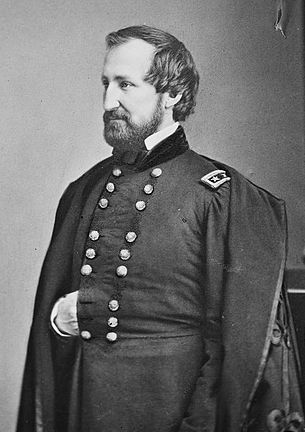
After the fall of Vicksburg in Mississippi, and Lee’s army being driven back into Virginia with their defeat at Gettysburg, the Union concentrated their efforts on gaining control of Chattanooga. When you look at the location of Chattanooga, you can see why. Chattanooga was well into southern territory and was considered “The Gateway to the deep South.” Chattanooga was the railroad hub of the south. Four lines radiated in four directions: to Nashville, Memphis, Atlanta, and Knoxville. After the fall of Vicksburg, middle Tennessee was the breadbasket for the south, providing wheat, corn, beef, pork, horses and mules. Without these provisions, the Confederate Army and much of the south would face starvation.
Both the north and south recognized the strategic importance of Chattanooga. A Confederate army stationed in Chattanooga could ride the train and reach most locations in south or north in a couple of days. Union control of Chattanooga meant that the city could be used as a staging ground for deeper penetration into the heart of the south.
President Lincoln had long recognized the importance of railroads in this area. In 1862 President Lincoln said, “To take and hold the railroad at or east of Cleveland, in East Tennessee, I think fully as important as the taking and holding of Richmond.” And in 1863 Lincoln wrote Maj. Gen. William S. Rosecrans, “If we can hold Chattanooga and East Tennessee, I think the rebellion must dwindle and die. I think you and Burnside can do this, and hence doing so is your main object.” President Lincoln had also promised the farmers of east Tennessee relief from the Confederates. These farmers were loyal to the Union and disliked the wealthy plantation and slave-owning class that ruled the Confederacy. Because of their loyalty to the Union, their crops and livestock were seized and their homes burned by the Confederate army. Many Unionists in Tennessee were killed.

Two Generals vied for control of Chattanooga. Major General William Rosecrans was a native Ohioan and graduated 5th in his class from West Point. He was a civil engineer before the Civil War and he had an engineer’s mind for battle planning. He was meticulous and often brilliant in his planning but, unlike in engineering, he was dealing with soldiers and officers in the Civil War who did not always follow his orders in the way he intended. His orders often lacked clarity, particularly in the heat of battle. Rosecrans assumed command of the Army of the Cumberland in October, 1862. On December 31, 1862, the Army of the Cumberland fought against the Confederate Army of Tennessee at the Battle of Stones River (Murfreesboro) just south of Nashville, Tennessee.

The General commanding the Army of Tennessee was Major General Braxton Bragg, a North Carolina native and a graduate of West Point. He was an artillery officer with distinguished service in the Mexican-American War. A lifetime military officer, he assumed command of the Army of Tennessee in November of 1862. Bragg could come up with brilliant plans but had a hard time changing them in the course of a battle. Because of this, his officers did not have confidence in him and were known to resist following his orders.
The Battle of Stones River was fierce with 25,000 casualties (killed, wounded or missing) but it ended without a clear victor. Bragg, knowing that Rosecrans would be receiving reinforcements, decided to retreat. Thus Stones River was effectively a Union victory because the Confederate army retreated. Rosecrans, however, did not order the pursuit of the Army of Tennessee. Instead, he allowed his army to rest and reprovision during the winter.
But the two men would soon meet again, wrestling for control of Chattanooga. What happened and where? You will have to wait until next week for the next installment of Civil War History in a nutshell.


I’m enjoying the stories of the Civil War. Thanks for researching and sharing! Rosemarie S.
Thanks Rosemarie. It is good to hear from you!